Abstract
Permian shale gas, a resource-rich energy source, has garnered significant attention in recent years regarding its organic matter enrichment characteristics. This study conducted detailed observations via scanning electron microscopy (SEM) and optical microscopy to clarify the differences in the types and assemblages of hydrocarbon-generating organisms across Permian shale formations in Northwestern Sichuan, as well as to determine the characteristics of organic matter sources. The types and combinations of hydrocarbon-generating organisms in the Gufeng Formation, Wujiaping Formation, and Dalong Formation in Northwestern Sichuan are systematically summarized. Based on this information, the primary sources of organic matter in the Permian shale were analyzed. Hydrocarbon-generating organisms in the Permian shales of the study area are predominantly acritarchs (a type of planktonic algae), followed by higher plants and green algae. In the Gufeng Formation, acritarchs constituted the vast majority of hydrocarbon-generating organisms, with smaller amounts of higher plants and green algae. At the bottom of the Wujiaping Formation, the relative acritarch content decreases significantly, while that of higher plants substantially increases. In the Dalong Formation, acritarchs regain dominance, and higher plants decline, resembling the Gufeng Formation in microorganism composition. The relative content of green algae shows minimal variation across all layers. Overall, the organic matter sources of Permian shale in the study area were mainly acritarchs (derived from planktonic algae), followed by green algae, and terrestrial higher plants. During the Gufeng Formation period, the sea level was relatively high. The Kaijiang–Liangping Trough in Northwestern Sichuan was generally a siliceous deep shelf. The main source of organic matter was aquatic planktonic algae, containing a small amount of terrigenous input. At the bottom of the Wujiaping Formation, the sea level was relatively low, resulting in the overall coastal marsh environment of the Kaijiang–Liangping Trough, which was characterized by mixed organic matter sources, due to an increase in terrigenous organic matter content. The sedimentary environment and organic matter sources of the Dalong Formation were similar to those of the Gufeng Formation. This research can provide a theoretical basis for exploration and development of Permian shale gas.
1. Introduction
The Permian shale gas resources in the Northwestern Sichuan Basin exhibit enormous potential as a clean energy source, with significant progress in exploration and development achieved in recent years. The Dalong and Gufeng Formations are core exploration targets [1,2,3,4]. Research on the origins of organic matter in shale is critical for shale oil–gas exploration as it clarifies the types and assemblages of hydrocarbon-generating organisms, which could help reveal the hydrocarbon generation potential of source rocks and aid in resource evaluation [5,6,7,8,9,10]. The organic matter sources of Permian shales were diverse and were mainly influenced by the paleoenvironment, paleoclimate, and biological communities during that time. The planktonic algae that flourished in the ocean (such as cyanobacteria, green algae, etc.) were important sources that were especially well-preserved in oxygen-deficient environments, forming the high organic carbon content in Permian shales [11]. Anaerobic bacteria decompose organic matter in an anoxic environment, contributing to the organic carbon and possibly forming sulfides (such as pyrite). The organic remains of other tiny marine organisms (e.g., foraminifera and radiolarians) could also be components of the organic matter in Permian shales [12]. In addition, the debris of terrestrial higher plants)—especially flourishing gymnosperms and ferns—in the Permian period (particularly the Late Permian) could have been transported into the ocean through rivers, contributing organic matter to marine shale [13]. However, the contribution of higher plants was more significant in the shale close to the continental margin. The spores and pollen from higher plants might have spread very far from land, carried by wind or water, mixing into marine shale and contributing to the organic matter [11]. Researching the types and assemblage characteristics (biological facies) of the hydrocarbon-generating organisms in shale is important for classifying the organic facies of shale and accurately evaluating the quality of potential source rocks for shale gas.
Previous studies indicate that the strata of the Gufeng Formation primarily consist of carbonaceous siliceous mudstone deposited in the basin, with localized development of the outer slope through the deposition of organic-rich argillaceous limestone. The organic matter in the Gufeng Formation mainly originates from primary aquatic organisms, such as plankton and algae, with minor contributions from terrestrial higher plants [14]. The bottom of the Wujiaping Formation consists of tidal-flat argillaceous siltstone interbedded with coal seams, with organic matter derived from marine plankton and algae [12,13]. In the Northwestern Sichuan Basin, the hydrocarbon-generating organisms of the Dalong Formation were predominantly primary aquatic organisms, such as algae and plankton [15,16]. A microscopic analysis of Well Heba-1 revealed that sapropelinite dominated the organic macerals (78.5–85.5%), primarily composed of alginite. Scanning electron microscopy (SEM) also identified the presence of carbonaceous particles—structurally similar to sulfur bacteria—in the Dalong Formation, confirming algae as a key source of organic matter [17]. Most of the algae in Permian shales exist in the form of acritarchs, with the organic matter wall cysts retaining their appearance [11,12,13].
The Upper Permian shale in the Northwestern Sichuan Basin is characterized by substantial thickness, diverse lithofacies, and multiple sedimentary facies, with Type I-II organic matter [18,19,20]. These variations imply significant changes in the environment during deposition, leading to heterogeneous organic matter sources and hydrocarbon-generating organisms. However, existing research on the types and assemblages of hydrocarbon-generating organisms of the Upper Permian shale is inadequate, which is unfavorable for the study of organic matter origins. Therefore, it is necessary to analyze the types and distribution of hydrocarbon-generating organisms in the Permian shale of the northwestern Sichuan Basin in detail, to clarify the differences in biogenic assemblages across formations and estimate organic matter enrichment mechanisms.
In this study, hydrocarbon-generating organisms in the Gufeng Formation, at the bottom of the Wujiaping Formation, and in the Dalong Formation have been classified and comprehensively characterized based on SEM and microscopy data. The primary sources of organic matter in these layers are also discussed. This work provides a theoretical foundation for evaluating the potential of Permian shale gas and predicting favorable exploration zones.
2. Geological Setting
The study area was located at the northwestern margin of the Yangtze Plate. During the Permian, this area was influenced by the subduction of the Paleo-Tethys Ocean and the closure of the Qinling Ocean, resulting in alternating extensional and compressional regimes [21,22]. In the Middle–Late Permian, regional compression led to the formation of carbonate platforms and transitional facies, alongside uplift and faulting activities in local areas, which resulted from the impending collision between the Yangtze and North China Plates (Figure 1) [23,24,25]. The development of Permian marine shale in the north of the Sichuan Basin was controlled by the Kaijiang–Liangping Trough, which was distributed in a banded pattern in the northern part of the Sichuan Basin. The depth of the Kaijiang–Liangping Trough was relatively large at the northern end, ranging from about 100 to 550 m in depth. This trough became shallow at the southern end, eventually disappearing. The morphology of the platform edge could be divided into the faulted steep slope type and the gentle slope type, which played important controlling roles in the formation of large shale gas reservoirs around the trough. The evolutionary history of the Kaijiang–Liangping Trough can be divided into three stages: (a) during the late Middle Permian, the trough was in the embryonic stage, beginning to form under the influence of regional tensile stress, mainly with lateral migration, It presents a northwest–southeast spread pattern, wider in the northwest and narrower in the southeast; (b) during the Late Permian, the trough went into its peak period of the development in the Changxing period, controlled by the expansion of the ocean and basement fault activities, with the internal development of deep-water siliceous limestone and radiolarian siliceous rocks, surrounded by shallow carbonate platform facies to form a complete deep-to-shallow water sedimentary sequence; (3) during the Early Triassic, the trough was in its extinction period—the closure of the ocean led to the gradual filling of the trough with sediments and its eventual extinction [26].
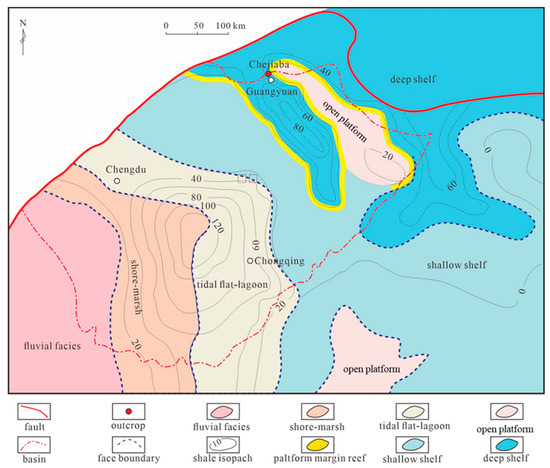
Figure 1.
Distribution of sedimentary facies in the Wujiaping Formation in the Sichuan Basin and its surrounding areas [25].
The Chejiaba outcrop is located in the Xibeixiang, about 12 km northwest of Guangyuan City, Sichuan Province. From bottom to top, this crop exposes the Middle Permian Gufeng Formation, the Upper Permian Wujiaping and Dalong Formations, and the Lower Triassic Feixianguan Formation. The strata of the Gufeng Formation are about 18 m thick, in which the lithology is composed of interbedded siliceous rocks and mudstones, with bioclastic limestone as an interlayer, indicating that the deep shelf environment was dominant during this period (Figure 2). The shale in the Gufeng Formation had high organic matter abundance (TOC: 3–10%) dominated by Type II kerogen [27,28]. The bottom of the Wujiaping Formation comprises yellowish or brown mudstone, grey calcareous shale with limestone as an interlayer (~4 m thick) (Figure 2). This member of shale is also known as the Wangpo Shale, with faveolate coal layers in some areas, suggesting a marsh lagoon in a bay environment. The upper member of the Wangpo Shale in the Wujiaping Formation is mainly grey limestone, indicative of an open carbonate platform environment. The organic matter content of the Wujiaping Formation is relatively low (TOC: 0.5–1.5%) and is primarily Type III kerogen [29]. The Dalong Formation is composed of black siliceous rocks, mudstones, and a thin layer of limestone (Figure 2). According to the types and assemblages of lithologies, this formation could be divided into the first and second members of the Dalong Formation from bottom to top. The first member of the Dalong Formation is about 20 m thick from the bottom, where the rocks are mainly composed of black, thin-layer siliceous rock and mudstone, with marl interbedded and some volcanic ash layers (Figure 2). The whole sedimentary environment was a deep shelf environment near the continental slope. The second member of the Dalong Formation is composed of dark gray argillaceous limestone interbedded with mudstone (Figure 2), meaning that the sedimentary environment during this stage was a slope environment at the edge of the carbonate platform, characterized by relatively deep, weak hydrodynamic and dysoxic water. The shale in the Dalong Formation has high organic matter content (TOC: 0.6–16.6%, avg. 4.58%) and enriched Type I–II kerogen [30,31,32].
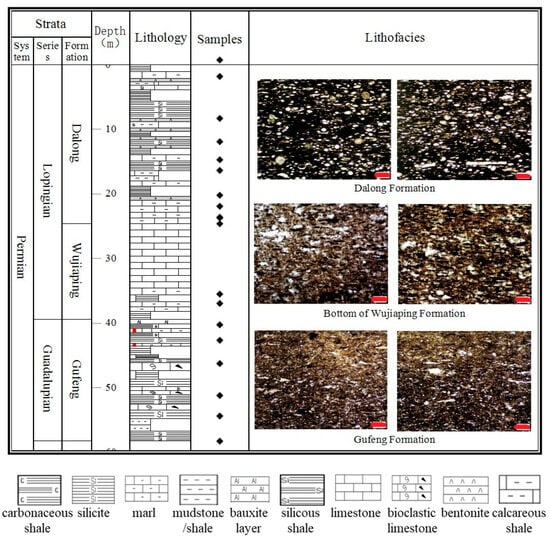
Figure 2.
Stratigraphic column and lithofacies distribution in the Chejiaba Outcrop, northwestern Sichuan (the red scale bars in the photographs are 200 μm).
3. Samples and Methods
A total of 20 samples were collected from the Gufeng Formation, the bottom of the Wujiaping Formation (~4 m from the bottom), and the Dalong Formation in the Chejiaba outcrop, Guangyuan area, northwestern Sichuan Basin (the locations of the 20 samples are marked in Figure 2). SEM was conducted at the Shenyang Geological Survey Center, China Geological Survey, using an SEM 3200, to observe microfossil types and quantify their abundance. The samples were systematically prepared for observation using the SEM. First, all samples were cut into equal squares of 10 mm × 10 mm using a precision cutting instrument to ensure consistency in the subsequent observation area. Subsequently, the surface of all samples was embedded with epoxy resin, and then mechanical polishing was carried out. To enhance conductivity, a gold coating with a thickness of 20 nm was sputtered and plated on the surface of all samples. In this study, the observation areas of each sample were the same (within 10 mm × 10 mm), and the quantitative statistical analysis of biological fossils in the SEM images was conducted using the standardized point counting method. The relative content of each microorganic fossil was calculated using the standardized formula Pi = (Ni/Nt) × 100%, where Pi is the percentage of type i fossil of the total fossils, Ni is the number of type i fossils, and Nt is the number of all observed organisms.
Palynological analysis involved extracting 50 g of shale to isolate sporomorphs (including algae, fungi, and acritarchs), structured organic matter, and amorphous organic matter. These components were identified and quantified under a microscope at the Department of Geology, Northeastern University. All samples were crushed to soybean size, and 50 g of each sample was added to a 1000 mL beaker. Concentrated hydrochloric acid was then slowly poured into each beaker while gently stirring with a glass rod. The mass ratio of hydrochloric acid to the sample was approximately 3:1. The samples were left to react for 24 h, gently stirring every 6 h until no further reaction occurred. Subsequently, the beakers were filled with distilled water and were left for 4–6 h, after which the upper clear liquid was poured out. This step was repeated 3–4 times until the pH value of the liquid in the beaker was approximately 7. The samples were then left to dry. Subsequently, hydrofluoric acid with a 3:1 acid-to-sample mass ratio was slowly poured into the beaker while gently stirring with a glass rod. After 24 h of standing reaction, samples were washed with distilled water 4–5 times. If the sample was not completely dissolved, additional hydrofluoric acid was added, and the sample washing steps were repeated until the samples were completely dissolved. The remaining residue of each sample was poured into a 50 mL centrifuge tube for centrifuging at a speed of 2000 revolutions per second for 10 min, and then the upper clear liquid was dumped. After centrifugation, the centrifuge tubes of each sample were inverted on a table for 24 h. When the liquid in the tubes was drained, the heavy liquid with a density between 2.0 g/cm3 and 2.2 g/cm3 was added to the tubes and stirred evenly with a glass rod. The samples in the centrifuge tubes with the heavy liquid were centrifuged for 20 min, after which the upper turbid liquid was poured into a 50 mL glass beaker. Then, 5% acetic acid solution was added to the glass beakers. The mixture in the glass beakers was left to stand for 48 h. When the deposits had completely settled, the upper clear liquid was poured out. The remaining turbid liquid was poured into a 10 mL centrifuge tube, and distilled water was added. The remaining turbid liquid with distilled water was centrifuged for 10 min. The centrifuging step was repeated 3–4 times until all the sediments in the small beaker were centrifuged. Finally, a small amount of the residue from each sample in the centrifuge tubes was taken to make temporary slides. The slides of the samples were observed using a Zeiss Primotech optical microscope at Northeastern University for biological classification and statistical analysis.
4. Results and Discussion
4.1. Types of Hydrocarbon-Generating Organisms
The microorganisms, such as bacteria, algae, fungi, and other types of organisms, lived during historical geological periods and were widely distributed in the oceans and lakes. They underwent complex biochemical and chemical changes during the thermal evolution stage [12]. Putrefaction and humification processes occurred during thermal evolution, converting the microorganisms into organic matter (kerogen), which served as the material basis for the formation of high-quality marine source rocks and could be the main original parent material for the formation of oil and natural gas. These organisms are microscopic and widely distributed in sedimentary rocks.
Alginite constitutes the most prevalent and widely distributed hydrocarbon-generating organism in the Permian shales of the northwestern Sichuan Basin. This organism can be further classified as acritarchs and green algae based on morphological characteristics. Acritarchs are a group of microfossils with multiple sources and various genetic relationships. Previous studies suggest that the main components of the cell walls of acritarchs are cellulose and pectin, similar to those found in the cell walls of planktonic algae [33]. Most of the algae in the Permian shale exist in the form of organic-walled cysts; therefore, the acritarchs may be organs or certain parts of planktonic algae. The types of acritarchs in this study have been classified into seven genera based on morphological dimensions [34]. Common genera such as Proterocladus, Siphonophycus, Polyedryxium, and Veryhachium are distributed across all stratigraphic units, while others (e.g., Cymatiosphaera, Lophosphaeridium, Dictyotidium) occur sporadically. These genera are described as follows:
Proterocladus (Figure 3a–c): the unbranched or occasionally branched filamentous structures could be observed under SEM with distinct septa. Their cell walls are thin and smooth, varying in length (typically longer than they are wide). The apical morphology ranges from simple rounded to capitulum structures.
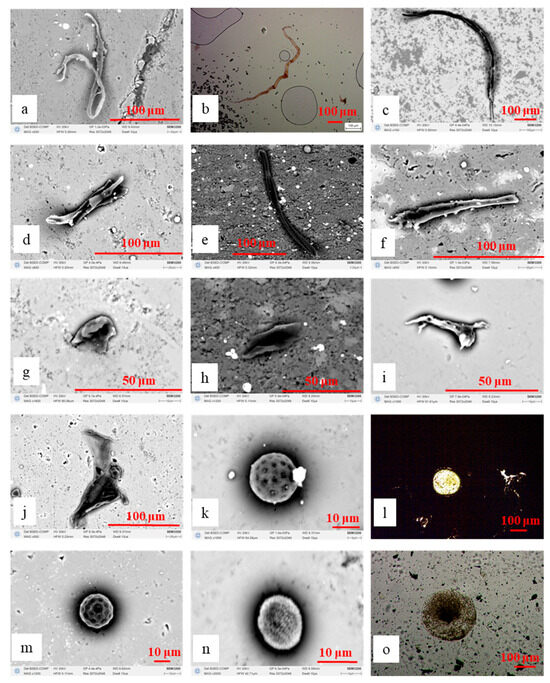
Figure 3.
Typical photos of acritarchs in the Permian shale of the Chejiaba outcrop. (a) Proterocladus, bottom of Gufeng Formation; (b) Proterocladus, middle of Dalong Formation; (c) Proterocladus, upper of Dalong Formation; (d) Siphonophycus, upper of Gufeng Formation; (e) Siphonophycus, lower of Dalong Formation; (f) Siphonophycus, upper of Dalong Formation; (g) Polyedryxium, upper of Gufeng Formation; (h) Polyedryxium, lower of Dalong Formation; (i) Veryhachium, middle of Gufeng Formation; (j) Veryhachium, upper of Gufeng Formation; (k) Cymatiosphaera, bottom of Gufeng Formation; (l) Cymatiosphaera, middle of Gufeng Formation; (m) Cymatiosphaera, upper of Gufeng Formation; (n) Lophosphaeridium, bottom of Gufeng Formation; (o) Dictyotidium, lower of Dalong Formation.
Siphonophycus (Figure 3d–f): it has a tubular and filamentous form with hemispherical terminations, but without septa or branches. This kind of acritarch often experienced deformation, such as twisting or folding.
Polyedryxium (Figure 3g,h): it is a type of slightly translucent and soft microplankton with polygonal membrane structures. The membrane surface consists of uneven organic layers, forming internal cavities of varying sizes. The single-layered membrane ranges from 10 to 150 μm in diameter and 0.5 to 3.0 μm in thickness, with a smooth or slightly undulating surface.
Veryhachium (Figure 3j): this kind of acritarch is characterized by triangular to quadrangular membrane outlines, with smooth to slightly rough surfaces. The membrane shell is a single-layer structure of the cell wall, in the shape of a cushion without striations or secondary spines.
Cymatiosphaera (Figure 3k–m): these fossils are spherical, 10–150 μm in diameter. They show spherical membranes with polygonal pores (3–6 μm in diameter) and irregular tubercles at pore bases.
Lophosphaeridium (Figure 3n): the membrane shell is spherical (approximately 10 μm in diameter), with small spinose tubercles of uniform thickness distributed in regular rows across the surface. The tubercles are approximately 0.2 μm in height.
Dictyotidium (Figure 3o): they show spherical membranes (10–200 μm in diameter) with polygonal reticulate patterns (mesh diameter: 0.5–3 μm). There are slight differences in appearance among different species.
A large number of spore-like microfossils were observed in Permian shales from the northwestern Sichuan region. These spore-like microfossils were classified as cryptospores and were assigned to the genus Adinosporus under the Chlorophyta (green algae) through comparative identification. The SEM images reveal that the cryptospores were well-preserved due to their rigid outer walls (Figure 4). This kind of cryptospore lacks the trilete marks (three radiating fissures) that are characteristic of typical spores [35,36]. These cryptospores typically consist of one or more subspherical spore-like cells, appearing as single spores, tetrads, or flower-like clusters under the microscope. Their spore walls exhibit a single-layered or multi-layered structure and may display pronounced folding (Figure 4).
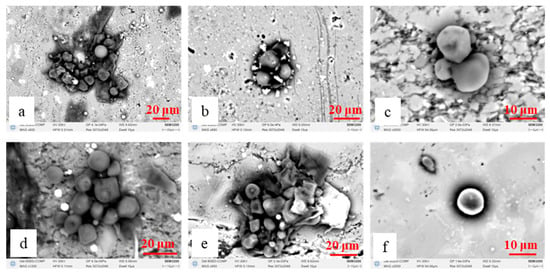
Figure 4.
Typical photos of cryptospores in the Permian shale of the Chejiaba outcrop. (a) Middle of Gufeng Formation; (b) upper of Gufeng Formation; (c) middle of Wujiaping Formation; (d) lower of Dalong Formation; (e) middle of Dalong Formation; (f) upper of Dalong Formation.
In addition to alginite, fragments of higher plants were identified in the samples. These fragments retain partial cellular structures, existing as diverse morphologies (commonly arranged in filamentous patterns), which could be easily recognized under a microscope (Figure 5). Abundant plant debris was observed at the bottom of the Wujiaping Formation in the Chejiaba outcrop.
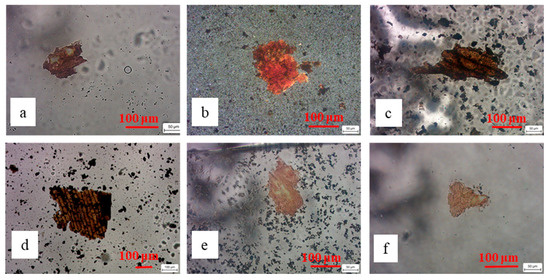
Figure 5.
Typical photos of plants in the Permian shale of the Chejiaba outcrop. (a) Top of Gufeng Formation; (b) bottom of Wujiaping Formation; (c) bottom of Wujiaping Formation; (d) bottom of Wujiaping Formation; (e) lower of Dalong Formation; (f) middle of Dalong Formation.
4.2. Distribution of Hydrocarbon-Generating Organisms
The hydrocarbon-generating microorganisms in the Permian shale from the study area could be generally classified into three types: acritarchs, green algae, and fragments of higher plants. In the different Permian shale formations, the relative contents of the three types of hydrocarbon-generating microorganisms show an obvious change from bottom to top (Figure 6 and Figure 7).
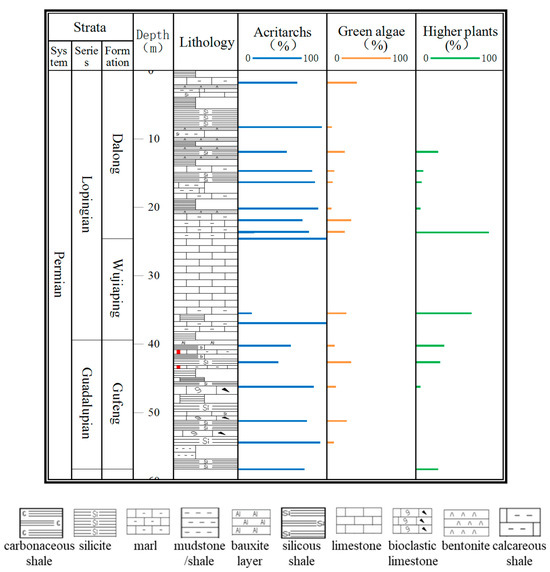
Figure 6.
Column of hydrocarbon-forming organisms distribution in the Chejiaba outcrop.
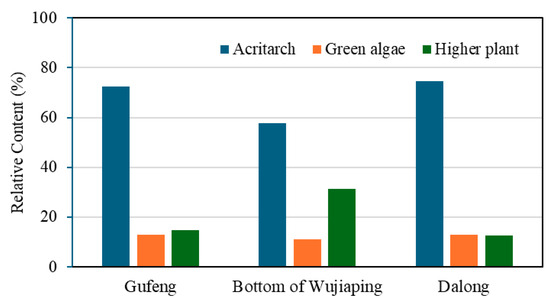
Figure 7.
Distribution bar chart of hydrocarbon-generating organisms in different layers of Permian shale in the Chejiaba outcrop.
The hydrocarbon-generating organisms in the Gufeng Formation of the Chejiaba outcrop are predominantly acritarchs (derived from planktonic algae). The relative acritarch content is very high, averaging 72.5%. Green algae are less abundant, averaging 12.7%, with no obvious changing trend (Figure 6 and Figure 7). Higher plants have an average content of 14.8%, showing an obviously upward-increasing trend in the upper area of the Gufeng Formation, indicating enhanced terrestrial organic input during this period (Figure 6 and Figure 7).
The hydrocarbon-generating assemblage at the bottom of the Wujiaping Formation consists mainly of acritarchs and higher plants. The average acritarch content decreases to 57.8%, and green algae decline to 10.9%. In contrast, the average content of higher plants increases significantly to 31.3%. The reduced proportion of acritarchs and the marked rise in higher plants reflect increased contributions from terrestrial input compared with the Gufeng Formation (Figure 6 and Figure 7).
The Dalong Formation consists of a similar hydrocarbon-generating assemblage to the Gufeng Formation, dominated by acritarchs (average content: 74.6%). Its higher plant content is only 12.4%, with elevated concentrations primarily observed at the bottom of the Dalong Formation. This suggests that the sea level was low at the beginning of the Dalong Formation, and then transitioned to deeper water later on as higher plants gradually diminished (Figure 6 and Figure 7).
4.3. Enrichment Model of Multi-Source Organic Matter
The hydrocarbon-generating organisms of marine source rocks are mainly composed of the debris of plankton (planktonic algae) and benthic organisms (benthic algae, sporangia, and spore walls), bacterial remains, and some plant fragments (linear leaves and higher plants). The organic matter in the high-quality marine shales of South China often has the characteristic of multiple resources. Therefore, the organic matter in marine shale often consists of more than one type of parent material, which can include plankton, benthic organisms, fungi, and higher plants simultaneously [11]. According to the results discussed above, the acritarchs in the Permian shale most likely originated from planktonic algae, especially from the cysts of dinoflagellate, while the macroscopic fragments of planktonic algae are very few. Since the vast majority of planktonic algae mainly exist in the form of acritarchs, the planktonic algae content is represented by acritarchs when determining the source of organic matter in Permian shale.
Previous studies suggest that some kinds of acritarchs, such as Proterocladus, Siphonophycus, Veryhachium, and Dictyotidium, primarily lived in a shallow marine environment [37,38]. These typical shallow-water acritarchs can be found across all upper Permian layers of the Chejiaba outcrop, implying that the study area was predominantly situated in a shelf environment during the depositional period of Permian shales. Combined with the data of lithology from the Chejiaba outcrop and previously published conclusions, the Permian marine shale in the northwest of the Sichuan Basin was mainly deposited in a deep shelf environment and was controlled by the tectonic evolution of the Kaijiang–Liangping Trough. Therefore, the Permian marine shale was deposited in a stable anoxic reduction environment, which was conducive to the enrichment of organic matter in the shale. The shale in northwestern Sichuan Basin is mainly siliceous shale and silicite, which are characterized by high TOC. The shales of the Gufeng and Dalong Formations are superior among the strata. In particular, the shale in the Dalong Formation formed in a high-productivity environment where distant volcanic activities were superimposed. The volcanic tuff interlayers that frequently occurred in the Dalong Formation could promote increased productivity, as well as the preservation of organic matter. Overall, the sedimentary environment of Permian marine shale in northwestern Sichuan Basin was characterized by deep water, low terrestrial input, high productivity, and anoxic sulfide water, forming a favorable layer for shale gas exploration. Based on these conclusions, the sources and evolution processes of organic matter in the Permian marine shales of the northwestern Sichuan Basin have been elucidated.
During the period of the Gufeng Formation, the deposition was mainly siliceous shale (Figure 2), indicating that the Kaijiang–Liangping Trough in northwestern Sichuan Basin was characterized by a siliceous deep shelf under high sea levels. Organic matter was primarily sourced from planktonic algae, with minor contributions from terrestrial input (Figure 8a). At the bottom of the Wujiaping Formation, the presence of a bauxite layer suggests that the sea level dropped dramatically (Figure 2), leading to a coastal swamp environment in the Kaijiang–Liangping Trough. The coastal swamp setting, caused by lower sea levels, increased terrestrial contributions while reducing planktonic algae dominance (Figure 8b). Afterwards, the study area transitioned to a carbonate platform in the middle–upper Wujiaping Formation (Figure 2), characterized by low organic matter content (Figure 8c). During the deposition stage of the Dalong Formation, the deposits were mainly siliceous shale and marl (Figure 2), which means the Kaijiang–Liangping Trough in the northwestern Sichuan Basin returned to a siliceous deep shelf, leading to a resurgence of planktonic algae as the primary organic matter source. (Figure 8d). On the whole, hydrocarbon-generating organisms in the Permian shales of the study area are dominated by acritarchs (derived from planktonic algae), followed by higher plants and green algae.
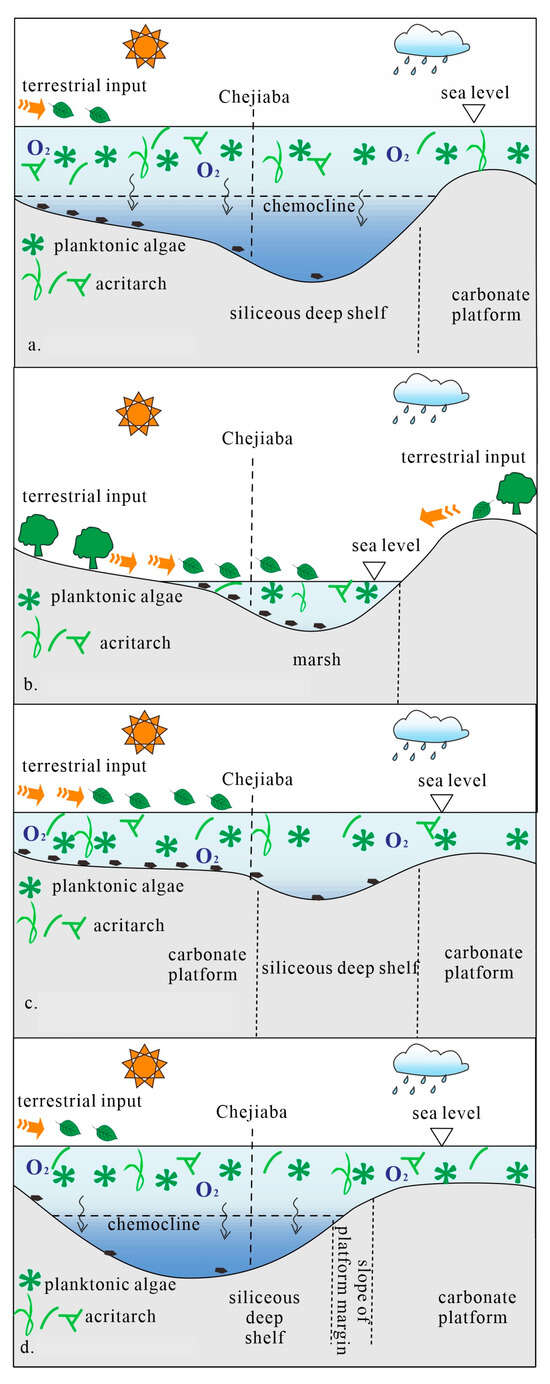
Figure 8.
Enrichment model of multi-source organic matter of Upper Permian shale in northwestern Sichuan. (a) Gufeng Formation; (b) bottom of Wujiaping Formation; (c) middle–upper of Wujiaping Formation; (d) Dalong Formation.
5. Conclusions
(1) The hydrocarbon-generating organisms in the Permian shales of the Chejiaba outcrop are predominantly acritarchs (derived from planktonic algae), followed by higher plants and green algae. In the Gufeng Formation, the proportion of hydrocarbon-generating organisms that are acritarchs is quite high, followed by higher plants and green algae. At the bottom of the Wujiaping Formation, the proportion of acritarchs gradually decreases, while higher plants increase significantly. In the Dalong Formation, the acritarchs regain dominance, resembling the microorganism composition of the Gufeng Formation. Green algae show minimal variation across all stratigraphic layers.
(2) The organic matter in the Permian shales primarily originates from acritarchs among planktonic algae, supplemented by green algae and terrestrial higher plants. During the stage of the Gufeng Formation, the Kaijiang–Liangping Trough in the study area was characterized by siliceous deep shelf facies with a high sea level. Organic matter was mainly derived from aquatic planktonic algae, with little terrestrial input. At the beginning of the Wujiaping Formation, low sea levels resulted in a coastal marsh environment, where organic matter sources were mixed, composed of planktonic algae and terrestrial input. The Dalong Formation was deposited in siliceous deep-shelf facies, with organic matter primarily sourced from aquatic planktonic algae and minor terrestrial input, similar to the Gufeng Formation.
Author Contributions
Conceptualization, Y.Z. and B.S.; methodology, Y.Z.; software, Y.L. (Yifei Li) and Y.L. (Yang Liu); validation, B.S., B.G. and D.F.; formal analysis, Y.Z.; investigation, M.L.; resources, B.S. and P.W.; data curation, Y.Z.; writing—original draft preparation, Y.Z.; writing—review and editing, D.F.; visualization, P.W.; supervision, B.S.; project administration, B.S.; funding acquisition, Y.Z. All authors have read and agreed to the published version of the manuscript.
Funding
This research was funded by [Sinopec Key Laboratory of Shale Oil/Gas Exploration and Production Technology], titled “Characteristics of Organic Matter Sources in Permian Marine Shale in the Northern Sichuan—Western Hubei Region and Their Impact on Reservoir Development”, No. 33550000-24-ZC0613-0045.
Data Availability Statement
The data that support the findings of this study are available from the corresponding author, upon reasonable request.
Conflicts of Interest
The authors declare no conflicts of interest.
References
- Guo, X.S.; Wang, R.Y.; Shen, B.J.; Wang, G.P.; Wan, C.X.; Wang, Q.R. Geological characteristics, resource potential, and development direction of shale gas in China. Pet. Explor. Dev. 2025, 52, 15–28. [Google Scholar] [CrossRef]
- Liao, F.; Wang, K.; Zhan, J.; Liu, Z.; Du, J.; Gong, S.; Cai, N.; Bai, J.; Zhang, J. Geological Conditions of Shale Gas Accumulation in Coal Measures. Processes 2024, 12, 1734. [Google Scholar] [CrossRef]
- Jin, Z.J.; Liu, G.X.; Wang, P.W.; Nie, H.K.; Li, M.; Wang, G.P. Exploration potential and targets of the Permian shale gas in the Yangtze region, South China. Oil Gas Geol. 2025, 46, 335–347. [Google Scholar]
- Li, R.; Xiong, Z.; Wang, Z.; Xie, W.; Li, W.; Hu, J. Lithofacies Characteristics and Pore Controlling Factors of New Type of Permian Unconventional Reservoir in Sichuan Basin. Processes 2023, 11, 625. [Google Scholar] [CrossRef]
- He, T.H.; Li, W.H.; Lu, S.F.; Yang, E.Q.; Jing, T.T.; Ying, J.F.; Zhu, P.F.; Wang, X.Z.; Pan, W.Q.; Zhang, B.S.; et al. Quantitatively unmixing method for complex mixed oil based on its fractions carbon isotopes: A case from the Tarim Basin, NW China. Pet. Sci. 2023, 20, 102–113. [Google Scholar] [CrossRef]
- Li, W.B.; Wang, J.; Jia, C.Z.; Lu, S.F.; Li, J.Q.; Zhang, P.F.; Wei, Y.B.; Song, Z.J.; Chen, G.H.; Zhou, N.W. Carbon isotope fractionation during methane transport through tight sedimentary rocks: Phenomena, mechanisms, characterization, and implications. Geosci. Front. 2024, 15, 101912. [Google Scholar] [CrossRef]
- Guan, M.D.; Wu, S.T.; Hou, L.H.; Jiang, X.H.; Ba, D.; Hua, G.L. Paleoenvironment and chemostratigraphy heterogenity of the Cretaceous organic-rich shales. Adv. Geo-Energy Res. 2021, 5, 444–455. [Google Scholar] [CrossRef]
- Xia, P.; Hao, F.; Yang, C.; Tian, J.Q.; Fu, Y.; Wang, K. Mechanism of organo-nickel co-enrichment in marine black shale. Adv. Geo-Energy Res. 2024, 13, 10–21. [Google Scholar] [CrossRef]
- Wang, E.Z.; Li, M.W.; Ma, X.X.; Qian, M.H.; Cao, T.T.; Li, Z.M.; Yang, W.W.; Jin, Z.J. Diahopane and diasterane as the proxies for paleoenvironment, hydrocarbon generation condition, and shale oil accumulation. Chem. Geol. 2024, 670, 122447. [Google Scholar] [CrossRef]
- Lu, H.; Pan, L.; Guo, Y.; Xiong, Q.; Dai, F.; Wang, S. Experimental Investigation of the Characteristics and Transformation Mechanism of Jimsar Oil Shale and Derived Shale Oil. Processes 2023, 11, 411. [Google Scholar] [CrossRef]
- Qin, J.Z.; Tao, G.L.; Teng, G.E.; Bian, L.Z.; Xie, X.M.; Fu, X.D. Hydrocarbon-forming organisms in excellent marine source rocks in south China. Pet. Geol. Exp. 2010, 32, 262–269. [Google Scholar]
- Qin, J.Z.; Shen, B.J.; Tao, G.L.; Teng, G.E.; Yang, Y.F.; Zheng, L.J.; Fu, X.D. Hydrocarbon-forming organisms and dynamic evaluation of hydrocarbon generation capacity in excellent source rocks. Pet. Geol. Exp. 2014, 36, 465–472. [Google Scholar]
- Teng, G.E.; Qin, J.Z.; Fu, X.D.; Yang, Y.F.; Xie, X.M. Hydrocarbon source rocks eveluation of the Upper Permian Wujiaping Formation in northeastern Sichuan area. J. Palaeogeogr. 2010, 12, 334–345. [Google Scholar]
- Zhao, Q.F.; Xie, D.Z.; Chen, J.W.; Liang, J.; Zhang, Y.G.; Wang, J.Q.; Dong, H.P.; Yuan, Y. Evaluation and biogenetic derivation and sedimentary environment of source rocks from Permian in the Lower Yangze region. Geol. Bull. China 2023, 42, 1154–1165. [Google Scholar]
- Shen, J.; Lei, Y.; Algeo, T.J.; Feng, Q.L.; Servais, T.; Yu, J.X.; Zhou, L. Volcanic Effects on Microplankton during the Permian-Triassic Transition (Shangsi and Xinmin, South China). Palaios 2013, 28, 552–567. [Google Scholar] [CrossRef]
- Zhang, Y. Forms and Distribution Characteristics of Organic Matter and Controlling Factors on Organic Matter Accumulation in the Latest Permian Dalong Formation, Northern Margin of Upper Yangtze. Ph.D. Thesis, China University of Geosciences, Wuhan, China, 2017. [Google Scholar]
- Fu, X.D.; Qin, J.Z.; Teng, G.E.; Wang, X.F. Evaluation on Dalong Formation source rock in the north Sichuan Basin. Pet. Geol. Exp. 2010, 32, 566–571. [Google Scholar]
- Zhang, Z.Y.; Xu, S.; Gou, Q.Y.; Li, Q.Q. Reservoir Characteristics and Resource Potential of Marine Shale in South China: A Review. Energies 2022, 15, 8696. [Google Scholar] [CrossRef]
- Wei, H.Y.; Hu, D.; Qiu, Z.; Zhang, X.; Liu, W.; Kong, W.L.; Ahmed, M. Sedimentological and Geochemical Characteristics of Late Permian Organic-Rich Rocks in North Sichuan and West Hubei Provinces. Acta Sedimentol. Sin. 2024, 42, 774–798. [Google Scholar]
- Yang, X.; Yang, Y.R.; Zhang, J.Y.; Tian, H.; Wang, Q.; Song, F.; Zhang, S.K.; Chen, Y. Characteristics and formation mechanism of Permian marine shale of Kaijiang-Liangping trough in northern Sichuan Basin. Lithol. Reserv. 2025, 37, 108–119. [Google Scholar]
- Kong, W.L. Research of Sedimentary Facies and Paleogeography of Middle and Later Permian in the Northern Margin of Middle and Upper Yangtze Region. Ph.D. Thesis, Hefei University of Technology, Hefei, China, 2011. [Google Scholar]
- Li, R.B.; Pei, X.Z.; Liu, Z.Q.; Li, Z.C.; Ding, S.P.; Chen, Y.X.; Liu, Z.G.; Zhang, X.F.; Chen, G.C. Stratigraphic Correlations of Two Different Types of Permian Strata and Their Regional Tectonic Significance in Zhenba-Gaochuan Area, Northern Margin of Yangtze Block. J. Earth Sci. Environ. 2011, 33, 125–131. [Google Scholar]
- Zhang, X.H.; Chen, C.; Huang, J.; Wen, L.; Xie, C.; Xu, S.W.; Gao, Z.L. The discovery of Middle Permian Guangyuan-Bazhong extensional trough in the Sichuan Basin and its petroleum geological significance. China Pet. Explor. 2019, 24, 466–475. [Google Scholar]
- Chen, Y.Z.; Zang, D.G.; Hu, G.; Feng, X.K.; Wang, X.Y.; Xiao, D.; Chen, Y.; Xu, M.; Liang, H.; Wu, Y.L.; et al. Tectonic framework and oil-gas geological significance of late Permian Changxing Period in Sichuan Basin. Earth Sci. Front. 2024, 1–10. [Google Scholar] [CrossRef]
- Zhao, P.R.; Gao, B.; Guo, Z.F.; Wei, Z.H. Exploration potential of marine-continental transitional and deep-water shelf shale gas in Upper Permian, Sichuan Basin. Pet. Geol. Exp. 2020, 42, 335–344. [Google Scholar]
- Xu, S.Y.; Xia, M.S.; Zhu, Y.; Li, T.J.; Lin, Y. Evolution stage and tectonic sedimentary characteristics of the Kaijiang-Liangping Trough. Fault-Block Oil Gas Field 2023, 30, 963–974. [Google Scholar]
- Qiu, Z.; Dou, L.R.; Wu, J.F.; Wei, H.Y.; Liu, W.; Kong, W.L.; Zhang, Q.; Cai, G.Y.; Zhang, G.; Wu, W.; et al. Lithofacies Palaeogeographic Evolution of the Middle Permian Sequence Stratigraphy and Its Implications for Shale Gas Exploration in the Northern Sichuan and Western Hubei Provinces. Earth Sci. 2024, 49, 712–748. [Google Scholar]
- Xie, J.P.; Li, Y.X.; Zhang, X.H.; Peng, H.L.; Gao, Z.L.; Li, T.J.; Zhu, J.C.; Hu, G. Evolution and sedimentary conditions of tension trough in Gufeng Member of Maokou Formation, northern Sichuan Basin. J. Chengdu Univ. Technol. (Sci. Technol. Ed.) 2025, 53, 1–15. [Google Scholar]
- Xie, J.R.; Zhao, L.Z.; Shen, P.; Zhang, B.J.; Zhang, X.H.; Chen, Y.G.; Chen, C.; Cen, Y.J.; Hao, Y.; Cao, H.; et al. New exploration discovery of facies controlled porous reservoir in the Wujiaping Formation of the Sichuan Basin and its significance to oil and gas exploration. Nat. Gas Ind. 2021, 41, 11–19. [Google Scholar]
- Guo, J.H.; Hu, G.Y.; He, K.; Mi, J.K.; Tian, L.J.; He, F.; Guo, C.Y.; Lu, M.D. Geochemical characteristics and sedimentary environment of source rocks of Permian Dalong Formation in northern Sichuan Basin. Lithol. Reserv. 2023, 35, 139–152. [Google Scholar]
- Wang, Y.; Bai, L.H.; Zhang, Y.L.; Zhang, X.M.; Yang, B.W.; Duan, K.; Wang, Y.; Xie, T. Reservoir Characteristics and Influencing Factors of Organic-Rich Siliceous Shale of the Upper Permian Dalong Formation in Western Hubei. Energies 2023, 16, 5130. [Google Scholar] [CrossRef]
- Ma, X.G.; Ye, Y.H.; Liu, S.G.; Song, J.M.; Wang, H.; Du, A.Y.; Chen, W.; Li, Z.W.; Dai, X.; Ming, Y.; et al. Sedimentary environment and organic matter enrichment mechanism of highorganic-rich black shale in the Upper Permian Dalong Formation in the eastern Sichuan Basin. Nat. Gas Geosci. 2025, 36, 621–636. [Google Scholar]
- Qin, J.Z.; Pan, A.Y.; Shen, B.J. Insoluble organic matter in source rocks: Derived from organic macromolecules in the skeleton, cell wall and shell of organisms. Pet. Geol. Exp. 2020, 42, 946–956. [Google Scholar]
- Yin, L.M.; Yuan, X.L.; Meng, F.W. Illustrated Book of Organic Walled Microfossils; Zhejiang University Press: Hangzhou, China, 2018. [Google Scholar]
- Yin, L.M.; Wang, C.J.; Zhao, Y.L.; Ou, Z.Y. Early-Middle Cambrian Palynomorph Microfossils and Related Geochemical Events in South China. J. Earth Sci. 2016, 27, 180–186. [Google Scholar] [CrossRef]
- Song, D. Hydrocarbon-Forming Organism Characteristics and Their Petroleum Geological Significance of High-Quality Source Rocks in the Lower Paleozoic in Southern China. Master’s Thesis, Nanjing University, Nanjing, China, 2019. [Google Scholar]
- Lei, Y.; Servias, T.; Feng, Q.L.; He, W.H. The spatial (nearshore–offshore) distribution of latest Permian phytoplankton from the Yangtze Block, South China. Palaeogeogr. Palaeoclimatol. Palaeoecol. 2012, 363, 151–162. [Google Scholar] [CrossRef]
- Li, D.D.; Luo, G.M.; Tang, Q.; She, Z.B.; Xiao, S.H. New record of the green algal fossil Proterocladus and coexisting microfossils from the Meso-Neoproterozoic Diaoyutai Formation in southern Liaoning, North China. Precambrian Res. 2023, 393, 107104. [Google Scholar] [CrossRef]
Disclaimer/Publisher’s Note: The statements, opinions and data contained in all publications are solely those of the individual author(s) and contributor(s) and not of MDPI and/or the editor(s). MDPI and/or the editor(s) disclaim responsibility for any injury to people or property resulting from any ideas, methods, instructions or products referred to in the content. |
© 2025 by the authors. Licensee MDPI, Basel, Switzerland. This article is an open access article distributed under the terms and conditions of the Creative Commons Attribution (CC BY) license (https://creativecommons.org/licenses/by/4.0/).